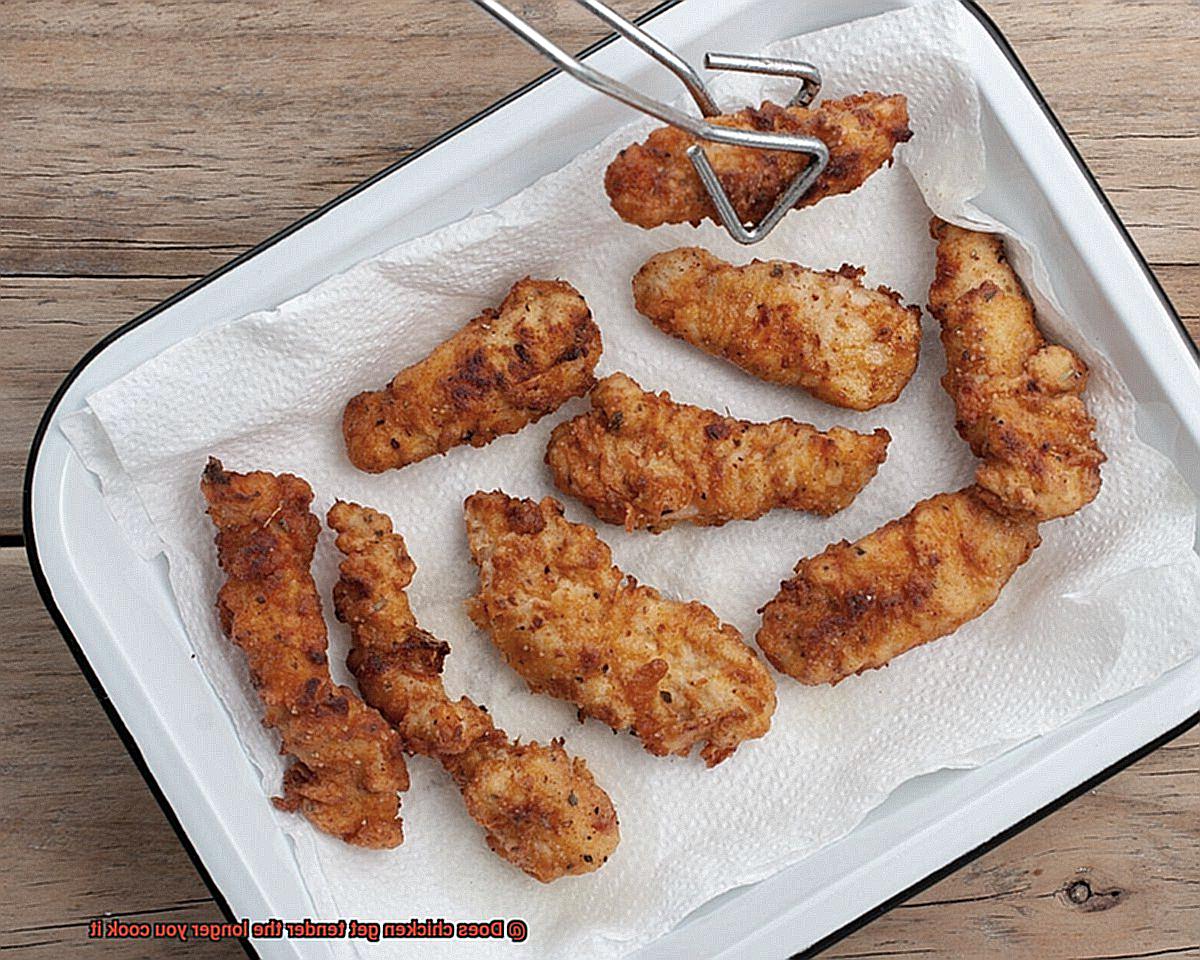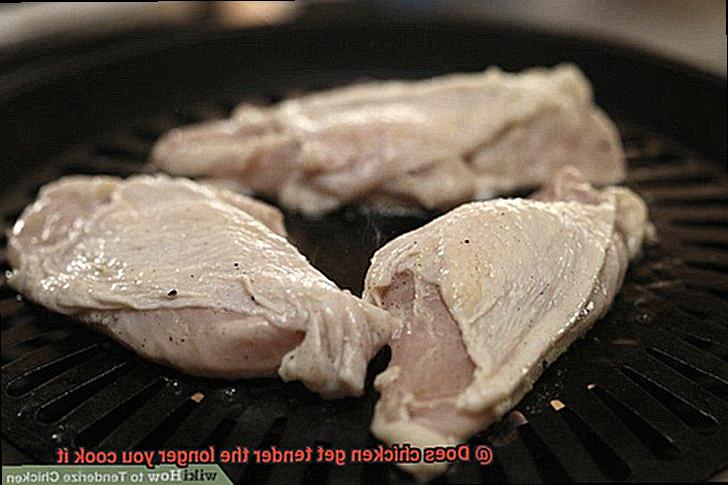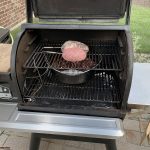You walk into the kitchen, eager to create a mouth-watering meal with chicken as the star attraction. But then, a nagging question pops into your head: Does chicken get tender the longer you cook it? It’s a dilemma that plagues both seasoned and novice cooks alike. Should you leave it on the heat for an extended period or take it off as soon as possible? Fear not, we’re here to put your mind at ease.
The widely held belief is that chicken should be cooked until there’s no pink left inside and juices run clear. But is that all there is to achieving tender, succulent chicken that’s safe to eat? The answer is more complex than a simple yes or no. In this blog post, we’ll delve into the science of cooking chicken and explore the factors that determine its tenderness. We’ll also share some insider tips and tricks to ensure your chicken is cooked perfectly every time.
From the temperature at which you cook the meat to the cut you choose, numerous factors impact whether chicken gets tender over time. By reading this post, you’ll have all the necessary knowledge to whip up juicy, tender chicken that will make your taste buds sing with delight. So grab your apron and let’s dive in.
Contents
What Factors Affect Tenderness in Chicken?
The tender and juicy chicken is the holy grail of any cook, but achieving it can be a tricky task. It’s essential to understand the factors that affect tenderness in chicken if you want to get it right every time.
Firstly, age and breed play a crucial role in how tender your chicken will turn out. Younger chickens are typically more tender than their older counterparts, while certain breeds are known for their exceptional tenderness. So, it’s essential to keep this in mind when selecting your chicken.
Another factor to consider is the cut of chicken being cooked. Different parts of the bird have varying levels of tenderness. For instance, breast meat is generally leaner and less tender than dark meat found in thighs and legs. Hence, choosing the right cut for your recipe can make all the difference.
The cooking method used also plays a significant role in determining chicken’s tenderness. Slow-cooking methods like braising or roasting at low temperatures can result in more tender chicken. In contrast, high-heat cooking methods such as grilling or broiling can quickly dry out the meat and make it tough.
Lastly, the amount of time you cook chicken can affect its tenderness up to a certain point. Overcooking chicken can actually make it tougher as the proteins in the meat continue to denature and coagulate, resulting in a dry, stringy texture. Therefore, it’s crucial to keep an eye on your cooking time and avoid overcooking.
Grilling Chicken Breasts
Grilling chicken breasts is a classic and delicious way to enjoy this versatile protein. But how can you ensure that your chicken is tender and juicy every time you fire up the grill? Let’s dive into the factors that can make or break your grilled chicken game.
Temperature is key when it comes to grilling chicken breasts. Cooking chicken at a high temperature for a shorter time can result in tender meat, while low temperatures for too long can dry it out. So, turn up the heat a bit to create that crispy exterior while keeping the inside nice and juicy.
Thickness matters too. Thinner cuts will cook faster and more evenly than thicker ones, which can take longer to cook through and may result in dry meat. If you have thicker cuts, you can always pound them to an even thickness before grilling to ensure that they cook evenly.
Marinating your chicken before grilling is also a great way to add flavor and tenderness. Acidic marinades containing vinegar or citrus juice can help break down the proteins in the meat, resulting in a more tender texture. But don’t overdo it on the marinade, too much acidity can lead to mushy meat.
Here are some additional tips worth mentioning:
- Oil your grill grates before cooking to prevent sticking.
- Avoid flipping your chicken too often as this can cause it to dry out.
- Let your chicken rest for a few minutes after grilling before cutting into it. This will allow the juices to redistribute throughout the meat, resulting in a more tender and flavorful final product.
Braising or Slow-Cooking Chicken Thighs and Legs
As an expert in this cooking technique, I’m here to share with you the steps to achieve a delicious and satisfying meal that will have your taste buds singing.
Firstly, let’s talk about the importance of searing. Searing the chicken in a pan over high heat is a crucial step to create a golden-brown crust, adding both flavor and texture to your dish. Once you’ve achieved that beautiful crust, it’s time to transfer the chicken to a pot or Dutch oven.
Now, it’s time to add some liquid and aromatics. Choose a flavorful liquid such as broth, wine, or tomato sauce, and don’t be afraid to add some onions, garlic, and herbs to enhance the taste. These small additions can make a world of difference in elevating the flavor profile of your dish.
Cover the pot with a lid and transfer it to a preheated oven or simmer on the stovetop over low heat. This is where the magic happens – the low and slow cooking method allows the connective tissues in the chicken to break down, resulting in tender and flavorful meat. Be patient. Depending on the size of your chicken pieces, this process can take anywhere from 45 minutes to 2 hours. But trust me; it’s worth the wait.
Once the chicken is cooked through and tender, remove it from the liquid and serve it up with your favorite sides like mashed potatoes or roasted vegetables. But don’t forget about that delicious liquid left in the pot. Reduce it down until it becomes a thick and flavorful sauce that you can drizzle over your chicken.
Overcooking Chicken
As a chicken connoisseur, I’m here to help you avoid this common mistake and achieve perfectly cooked chicken every time.
Firstly, let’s talk about cooking time and temperature. The ideal internal temperature for chicken is 165°F (74°C). Overcooking your chicken beyond this temperature or cooking it for too long will result in meat that is dry and difficult to chew. Investing in a meat thermometer is an excellent way to ensure that your chicken is cooked to perfection.
Choosing the right cooking method is also crucial. Grilling, baking, and roasting are all fantastic methods for cooking chicken, but each requires different times and temperatures. Grilling is ideal if you’re short on time, while baking or roasting takes a little longer. Whatever method you choose, make sure to keep a close eye on your chicken to prevent overcooking.
Marinating your chicken before cooking can also make a world of difference. A marinade made with acidic ingredients like lemon juice or vinegar can help break down the fibers in the meat, making it more tender and juicy.
In summary, here are the key takeaways:
- Cook chicken until it reaches an internal temperature of 165°F (74°C).
- Choose the right cooking method for your needs.
- Marinate your chicken before cooking to keep it moist and tender.
Monitoring Internal Temperature of the Chicken
Then it’s time to talk about monitoring the internal temperature of your chicken. Not only is this important for safety reasons, but it also plays a vital role in the tenderness of your chicken.
To ensure that your chicken is safe to eat, it needs to be cooked to a temperature of 165°F (75°C), as recommended by the USDA. But how do you know when your chicken has reached this temperature? The answer is simple: use a meat thermometer.

There are two types of meat thermometers available – instant-read and leave-in. Instant-read thermometers are perfect for checking the temperature quickly, while leave-in thermometers can be left in the chicken while it cooks to monitor the temperature continuously. Whichever type you choose, make sure to insert it into the thickest part of the chicken, avoiding any bones or gristle. And speaking of bones, make sure your thermometer isn’t touching any bones when you take your reading as this can lead to an inaccurate reading.
But monitoring internal temperature alone won’t guarantee tender chicken. The cooking time also plays a crucial role in achieving tenderness. Overcooking can result in tough and dry meat, while undercooking can lead to rubbery texture. Therefore, it’s essential to check the internal temperature in multiple areas to ensure that it has reached 165°F (75°C) throughout. For a whole chicken, check the thickest part of both the breast and thigh meat.

Does Cooking for a Longer Time Result in Tender Meat?
Let’s dive into a common myth about cooking meat – the idea that a longer cook time equals more tender meat. While this may hold true for certain cuts, chicken is not one of them. In reality, cooking chicken for an extended period can actually lead to dry and tough meat.
Why is this the case? Chicken is a lean protein with minimal fat content, making it susceptible to dryness when overcooked. Overcooking can cause the meat to lose its natural juices and flavor, leaving you with a chewy and unsatisfying meal.
So, does cooking chicken for a longer time result in tender meat? The short answer is no. While prolonged cooking may break down some connective tissues, it can also make the meat dry and stringy. To achieve tender and juicy chicken, it’s essential to cook it just long enough to reach the appropriate internal temperature without overcooking it.
One way to ensure this is by using a meat thermometer to check that the chicken reaches a safe internal temperature of 165°F (74°C) without surpassing it. However, internal temperature isn’t the only factor affecting tenderness. Pre-cooking techniques such as marinating or brining can also help break down muscle fibers and keep the chicken moist during cooking.
Tips to Achieve Optimal Results
Cooking chicken to perfection is a skill that requires a few tips and tricks. Achieving optimal results means having tender, juicy, and delicious meat every time. Here are five sub-sections that will help you cook the perfect chicken:
Marinate the Chicken:
Marinating chicken before cooking is an excellent way of adding flavor and making it more tender. A marinade can be made with simple ingredients like olive oil, garlic, salt, and pepper or with more complex herbs and spices. Marinating chicken helps to break down the proteins and make it more tender.
Cook at the Right Temperature:
Cooking chicken at too high a temperature can cause it to become dry and tough, while cooking at too low a temperature can result in undercooked, tough meat. The recommended internal temperature for cooked chicken is 165°F (75°C). Aim for a moderate temperature of around 375-400°F to achieve optimal results.
Let the Chicken Rest:
After cooking, let the chicken rest for a few minutes before serving. This allows the juices to redistribute throughout the meat, making it more tender and juicy.
Use a Meat Thermometer:
A meat thermometer is an essential tool when cooking chicken (or any meat). It allows you to accurately gauge the temperature of the meat and ensure that it has reached a safe internal temperature without overcooking it. Insert the thermometer into the thickest part of the chicken to check if it has reached 165°F (75°C).
Brine the Chicken:
Brining chicken is another technique for making it more tender. Brining involves soaking the chicken in a solution of saltwater and other seasonings for several hours before cooking. The salt helps to break down the muscle fibers in the meat, resulting in a more tender texture.
j4wGe_AQHSg” >
Conclusion
To truly achieve tender, juicy chicken, one must understand the complex factors that affect its tenderness. It’s not as simple as cooking it for a certain amount of time. Age and breed, cut of meat, cooking method, and cooking time all play a role in the final result.
When grilling chicken breasts, it’s crucial to pay attention to both temperature and thickness. Marinating beforehand can also add an extra layer of tenderness. On the other hand, braising or slow-cooking chicken thighs and legs require a sear before adding liquid and aromatics for that fall-off-the-bone texture.
Dry meat is nobody’s idea of delicious, so monitoring internal temperature with a meat thermometer is essential. Overcooking can ruin even the most carefully prepared dish.
Marinating or brining beforehand can break down muscle fibers and keep the meat moist during cooking. Cooking at the right temperature and letting it rest afterward are also key contributors to achieving tender meat.
In summary, achieving perfect chicken requires attention to detail and a willingness to experiment with different methods.






